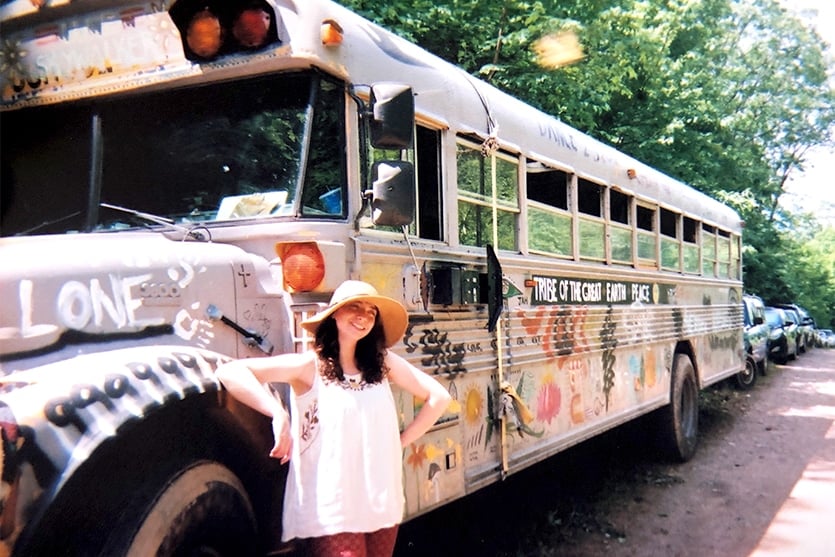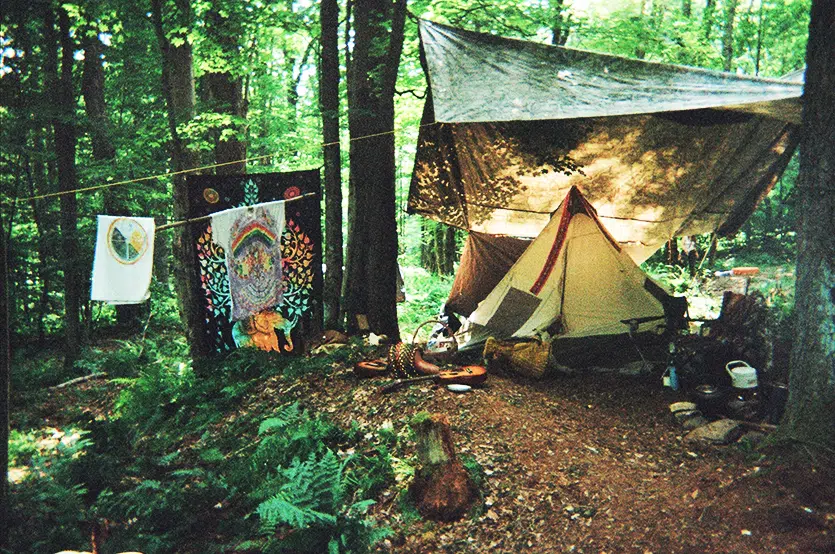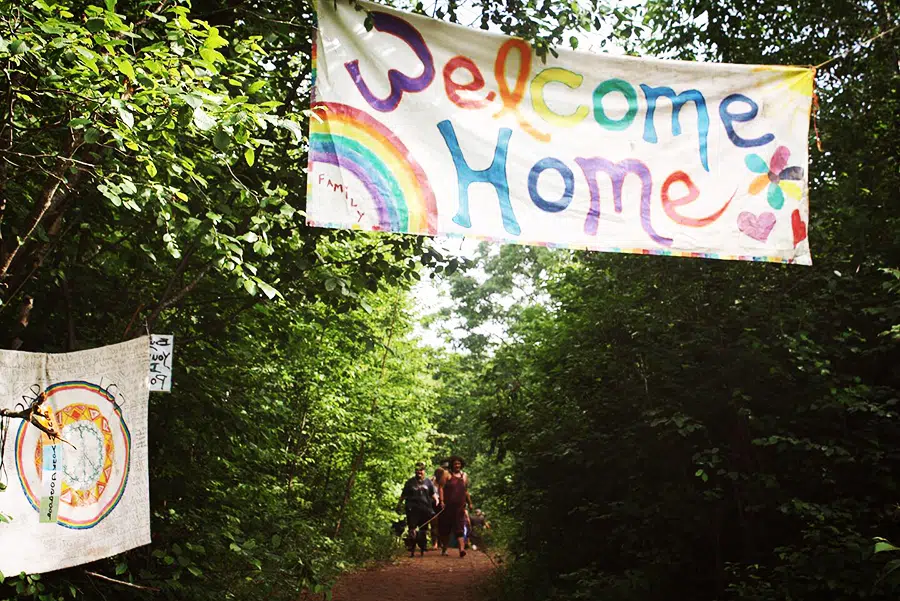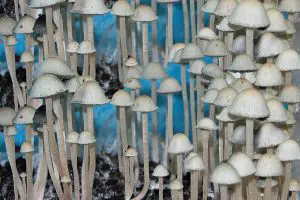It’s easy to fantasize about an idyllic psychedelic society at times like this. It’s almost as if we’ve all been dosed, collectively, with this drug called COVID that magnifies our fears, triggers mental unrest, and feels like a bad trip that just won’t end. Whether or not we’ve been infected with the virus, it leaves a psychological impression upon each of us—no matter if we choose to fear it or not—and at its worst, the drug called COVID can also kill you. When we look around and consider where to turn, we see fires and rising global temperatures—and we realize that the pandemic is our set and the climate crisis our setting for what’s undoubtedly been, at times, a challenging psychedelic experience for each of us individually, as well as for our collective consciousness.
Yes, we’re at a crossroads, a psychedelic moment in history: If nothing else good has come of this pandemic, at the very least it’s forcing us to question the paradigms of economics, medicine, and culture we’ve subscribed to for so long, shedding light on where the system, and the values that support it, are failing us. It’s also an opportunity to question which values we want to carry into the next era.
And so, as they say when you’re struggling through a difficult trip, the only way out is through. There’s no off-ramp for this juncture: If we’re enduring the shadow side of the psychedelic experience by virtue of today’s current events, then perhaps only through the application of psychedelic ideals might we make it through to the other side—and might I suggest, with a hint of optimism if not also some naiveté, we might even make it through to a better paradigm altogether.

So let’s return to that fantasy of the psychedelic society. I caught a glimpse of that lifestyle earlier this summer, at the regional Rainbow Gathering in the Allegheny National Forest of Pennsylvania, and at a Rainbow Gathering in rural Wisconsin a few years before that. Every year, thousands of Rainbow family make the trek to a remote national forest to simply live—to camp, to cook, to sing songs, and to collectively pray for world peace—silently holding hands in a circle on the 4th of July. This year, due to the pandemic, rather than one big gathering over the holiday week and weekend, Rainbow spliced off into three regionals around the country (Pennsylvania, New Mexico, and Idaho). Next year, the Gathering will be in Colorado, for its 50th anniversary.
Psychedelics are part of the culture at Rainbow, but they’re not the focal point (although “hard drugs” and alcohol are discouraged); rather the psychedelic ethos is part of the foundation upon which the culture of the Gathering is established. The Rainbow Gatherings officially began in 1972, serving as an opportunity to manifest, from scratch, a temporary society that upholds noncommercial, nonhierarchical, environmentally conscious ideals. Rainbow was the precursor to Burning Man: There are no leaders, no exchange of money (it’s free to attend), and no trace left behind once the gathering disassembles. Everyone has an equal opportunity to become a focalizer and manifest the vision. It’s rootsier than Burning Man, and more true to a psychedelic ethos that challenges a capitalist, consumerist paradigm in favor of a sustainable approach to life that can be applied and lived out beyond the scope of the annual Gathering. Rainbow is not a cathartic escape to the desert for a week; it has no Silicon Valley elites or class structure as defined as at the Burn.
Read: What Permaculture Teaches Us About Psychedelics
Most Rainbow camps and communal kitchens are a reflection of time and effort, rather than material resources. Rainbow is a lifestyle unto itself, and a philosophy that has guided activist work for decades. Take for instance some of the communal kitchens that were set up during the Occupy Movement, at disaster sites, or the Dakota Access Pipeline protests; those were led by Rainbow family who gained experience from the Gathering of setting up field kitchens in less than ideal environments (i.e. in raw forest).
How to Grow Shrooms Bundle
Take Both of Our Courses and Save $90!
If we think about psychedelic ethos and the integration of psychedelic values into our lifestyle, then Rainbow and the actions of Rainbow family outside the Gathering exemplify just that: If “oneness” is a psychedelic value—indeed one of the criteria that psychedelic scientists have identified as part of the so-called “mystical experience”—then feeling a sense of oneness to community and nature, and therefore a responsibility to it, reflects an integration of psychedelic values put into practice.
A number of service-oriented projects come out of Rainbow, but all organically, explains Tenali Hrenak, a member of the Rainbow family for the past 30 years, who leads disaster relief projects and collects field recordings of songs and sounds from the Gatherings. “It’s just a volunteer-driven phenomenon, and so if you look at Rainbow Gatherings as a phenomenon, the only overarching thing is that it’s a peace and healing gathering,” he says, describing the Gatherings as temporary autonomous zones with anarchistic undercurrents. “It’s a public event put on by the public for the public. Any sort of action that comes out of it is left to the devices of the people who gather.”

Hrenak says the service work is what brings him to Rainbow, and is what fuels him with joy—especially because the work transcends the scope of commercial exchange. “It’s not a vacation, it means I’m going to be working a lot, doing stuff for a community, whether it’s laying water lines, working in the kitchens, carrying in food, or helping in all sorts of ways,” he says. “There’s something inspiring about it that shows how the world could be outside a capitalist structure. Going to a Gathering is definitely mental hygiene in that it’s a reminder of what we can do: It highlights we can do more together than any of us can do on our own.”
Empathy and compassion are among the takeaways that Rainbow family glean from the Gathering, Hrenak adds, as a result of sharing things like food and resources. “It teaches you that we’re all connected and however mundane it is to say that, it’s true and Rainbow Gatherings highlight for me that we all don’t just live in our personal void. So much of society is divided and a Rainbow Gathering at its best cuts through all that bullshit: Nobody cares what you look like or where you’re from, just being a decent human being is what really matters.”
Read: Ego Death: Everything You Should Know
In “Babylon”—the world outside the Gathering—people are often valued monetarily: A person’s worth is measured by the amount of money they make per hour, or per year, notes Shmuel Leaderman, long-time Rainbow Family and a focalizer of the Home Shalom camp. But in the paradigm of “anarcho-communalism” that defines Rainbow, “we look at everyone equally,” he explains. Everyone has an equal opportunity—and responsibility—to contribute. That means digging a shitter if you don’t know where to go to the bathroom, helping to build a kitchen counter out of wood if you want your next meal prepared, or making friends if you need help getting something done. “If you’re bored, you don’t need to plug in your iPhone, you won’t get reception anyway, so you might as well pick up a guitar and play music or have a conversation or tell a joke and get yourself interesting and stop being used to being mediated,” says Leaderman. “If you’re not interesting enough, have some acid and things will get interesting then.”
Rainbow Gathering is like a psychedelic trip unto itself, both Leaderman and Hrenak agree. “There’s this psychedelic reset that people get into when you put people out of their element,” Leaderman says. Learning to survive in nature, he explains, breaks people down and puts them into a position to realign, in much the same way psychedelics do. Both the psychedelic experience, and the experience of Rainbow (whether or not you take psychedelics there) offer a new lens through which to process reality; and when people trip at the Gathering, Leaderman adds, it compounds the experience “like putting whipped cream on the cake.”
The absence of money at the Gathering also creates a more organic environment without the complications that commercialism or materialism bring to the table, he adds. “When you think, ‘maybe my blow dryer is not so important, maybe sitting around and holding a conversation with some confidence is more important than other things,’ it’s a reset on a psychological level, just as hallucinogens would be a reset for traumas.”

For Rickshaw, a Quaker who’s been going to Rainbow for the past 18 years, “the healing” is what keeps drawing him back. “I look at it as both a spiritual home and also a collection of revolutionary cells,” he says. “By escaping Babylon, the question is whether Babylon is in our heads or not.” One of the reasons Rainbow is so psychedelic in and of itself is that it takes us out of the dominant, mundane paradigm—much in the same way that psychedelics may cause ego death, enabling us to break out of old patterns and feel a greater sense of connection to the people, nature, and world around us.
“Rainbow is a way of teaching us that this [way of life] actually works and if we just apply it to the rest of our lives, we can escape a great deal from Babylon even if we’re surrounded by it: Our nonparticipation makes it fade away.” It’s a matter of a simple, psychedelic query, Rickshaw says: “Do we have love in our hearts and light in our head? Or do we have a bunch of money and violence in our heads, so that the battlespace is inside our skulls?”
That’s the Rainbow insight: The power to change our reality lies within our minds—an idea similar to the concept so aptly encapsulated in the title of a book by acid evangelist Timothy Leary, Your Brain is God. When everyone behaves as if money is real, says Rickshaw, then it’s real—but in the reality of Rainbow, money has no value. The only thing that gives something authority is when we give it residence in our minds, he explains. This isn’t to say money isn’t real, but like a psychedelic trip, Rainbow helps open our minds to notions we may not have considered through our mundane experience, and we realize the power that our consciousness has on tangible reality outside ourselves. “The ideas in our head, the false notions about what’s important and what’s real—that’s what we try to liberate ourselves from, even if momentarily, while we’re at the Gathering,” says Rickshaw. “And maybe over time it deepens, and we stay liberated even when we’re not at the Gathering.”
As with any psychedelic experience, the point isn’t just to have the experience only for the sake of itself, but to integrate its lessons into our everyday lives. The same is true of Rainbow. And the question becomes: What is the point of the Gathering, what significance does it bear on everyday life, on the systems that govern the majority of our realities, and on contemporary issues? And while the quantitative scope of the Gathering has dwindled over the past half century, with only a couple thousand per Gathering rather than tens of thousands, many Rainbow family members wonder how future generations will carry the torch.
Tsiporah Gottesman—a teacher of nonviolent communication and a friend with whom I co-created a womxn’s camp called Sarah’s Tent adjacent to Home Shalom at this year’s Rainbow— describes a moment at a Gathering a couple years ago in Georgia. “It was this magical late afternoon in Main Meadow and there was music playing and one of the elders looked around, in frustration at the newbies and young folk, and asked, ‘Why aren’t the hippies dancing?!’ It really struck me,” says Gottesman, who discovered Rainbow about 10 years ago. “Here you had this withered hippie elder and she’s looking around at what Rainbow’s become, and when she said that, it sparked something and everyone got up and started dancing.”
The values, concerns, and customs of the original generations of Rainbow Family no longer apply today as broadly; our generation faces different challenges, and as such our psyches, needs, and actions reflect that, for better and for worse. “Of course we want to keep the integrity of the original magic and we don’t want to be stuck recreating the same old thing—we want to see where the future takes us,” says Gottesman.
That’s where integration comes in, creating a relationship between the experience and the moments in between, when life happens. The two inform each other—and as such, our psychedelic experiences, including the experience of Rainbow Gathering, reflect what’s going on in everyday life, and therefore challenge us to change it where there’s room for improvement. But like a psychedelic trip, Rainbow also reflects the negative and the positive, offering a container through which to work through difficult moments of learning.

“If a person had a psychedelic experience, they can always reference it, and have psychedelic moments just by doing that,” says Gottesman, drawing a comparison to the Gathering. For those seeking a good set and setting to take psychedelics, Rainbow offers said opportunity. “It’s the most optimal playground for someone to be their own magical self, to let it fly,” says Gottesman. “But they don’t even have to take psychedelics. It’s a fertile playground to be psychedelic.”
Maybe it’s the drum circle in Main Meadow that lasts till dawn. Maybe it’s schlepping more than a mile into the gathering, trekking through mud, in order to set up camp and bring in all necessities like food and shelter materials. Maybe it’s asking a friendly neighbor to check you for ticks.
How to Grow Shrooms Bundle
Take Both of Our Courses and Save $90!
At Rainbow, I found myself in situations I never thought mundane life would present. I found myself trip-sitting a baby boomer who returned to acid for the first time in decades. I myself was on a bit of original “Rainbow Family” acid that a friend had given me, and here we were—surrogate mother and daughter—processing issues we each had in our respective parent-child relationships. At the Gathering, stone sober I sat on a rock with a friend and people watched; he’d been working on a goat farm a few months prior and noted that people are just like goats—here in the forest, in this temporary, made-up society, people just lived naturally, just as you’d observe a herd of other animals. At this year’s Gathering, I caught Lyme disease (despite all the tick checking), but so did nearly everyone else, and I feel an odd comforting sense of community in that; and in treating it, I’m learning that my psycho-somatic experience is not irrelevant to the core of wellness and healing, whether we’re talking about Lyme, COVID, or any other ailment. At this year’s Gathering, I met a high school chemistry teacher and his former student, a college kid and a fan of DoubleBlind. At a previous Gathering, I watched an elder, coming from a Jewish background, put on tefillin (prayer accessories) for the first time in decades. And at both the Gatherings I’d been to, I stayed up till sunrise, singing songs, shooting the shit, and having conversations that could only happen in an environment as unencumbered as Rainbow.
A doctor told me recently that I’ll probably always test positive for Lyme; but that I would also be okay. And I see that as a kind of biological tattoo, the kind that reminds you of an unforgettable experience—specifically, as Gottesman put it, the experience and opportunity to be psychedelic. When I think of how I regard my health and take care of myself vis-à-vis the Lyme, the COVID state of affairs, and the ills of the world-at-large, I think about integrating the psychedelic ethos of Rainbow into something I can draw from in Babylon. “It’s a really strong reference to living a different way,” says Gottesman. “And that is with a more loving lifestyle.”

DoubleBlind is a trusted resource for news, evidence-based education, and reporting on psychedelics. We work with leading medical professionals, scientific researchers, journalists, mycologists, indigenous stewards, and cultural pioneers. Read about our editorial policy and fact-checking process here.

DoubleBlind Magazine does not encourage or condone any illegal activities, including but not limited to the use of illegal substances. We do not provide mental health, clinical, or medical services. We are not a substitute for medical, psychological, or psychiatric diagnosis, treatment, or advice. If you are in a crisis or if you or any other person may be in danger or experiencing a mental health emergency, immediately call 911 or your local emergency resources. If you are considering suicide, please call 988 to connect with the National Suicide Prevention Lifeline.



